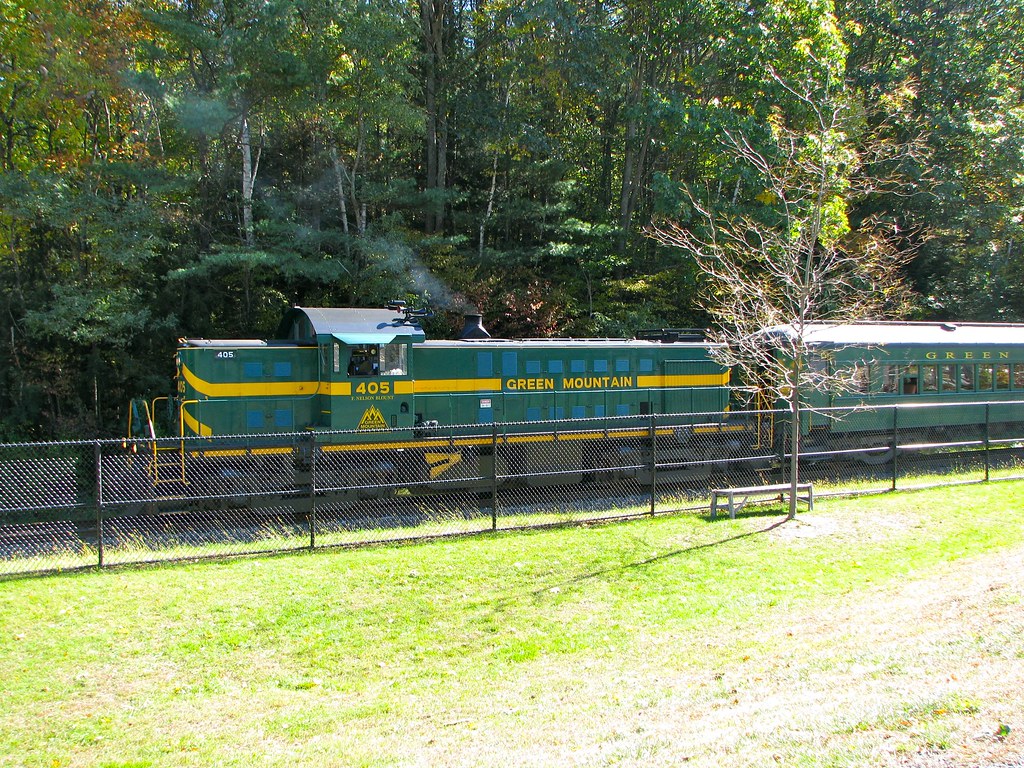That’s shortline (with a “t”) not shoreline. The term describes very small railroads.
I first became aware of shortlines a couple of years ago when we took a brief trip to Vermont during early Autumn. One of our activities included an excursion along the western bank of the Connecticut River. We took that trip on the White River Flyer, a vintage train belonging to the Green Mountain Railroad.

I didn’t discover that the railroad was an independent entity with only about 50 miles of track (all within Vermont) until I began writing an article on my travel site. My second encounter occurred as I researched a 12MC article on Railroad Ferries. I learned about the Bay Coast Railroad with 96 miles of track on the Delmarva Peninsula. It ran from Pocomoke City, Maryland to the southern tip of Virginia Eastern Shore and then via ferry to Norfolk. [Update: unfortunately it ceased operations in May 2018].
Until then I’d though that maybe only a handful of large railroads existed. However, that misconception couldn’t have been more completely wrong. I consulted American-Rails.com for an explanation. There I learned that shortlines “by far make up the bulk of railroads in the country today, totaling some 500.”
Definition
The U.S. Government tags shortlines with a more bureaucratic name. They call them “Class III” railroads. Those are defined as “Carriers having annual carrier operating revenues of $20 million or less after applying the railroad revenue deflator formula.” Feel free to examine the deflator formula on your own if that kind of thought excites you. I didn’t particularly care.
Thus, in the eyes of the government, the definition of shortlines doesn’t hinge on miles of track but on piles of cash. The Class III category contains an array of railroad types. The longer ones might connect a few towns to the larger railroad network. The Green Mountain Railroad excursion I experienced fit into that part of the definition. Others served as more specialized terminal or switching railroads. Those connected rail to other modes of transportation or simply moved cars within the confines of a rail yard.
I wondered what might be the shortest existing railroad and quickly concluded that it defied a simple answer. Trainweb provided a great list of very short railroads, with each line ten miles or shorter. I got lost on that page for awhile. The vast array of micro-railroads simply amazed me. The following instances fell amongst the shortest mentioned.
Kendallville, Illinois
The Kendallville Terminal Railway Co operates 1.1 miles of track. Essentially it serves a single function. The railway transports sugar and other cooking materials for the Kraft Foods marshmallow and caramel manufacturing plant. Sweet! The Kendallville railway also connects to the much larger Norfolk Southern Railroad, and offers facilities for railcar storage. So I guess it makes it something of a railway parking lot.
Google’s satellite view shows a few of those railcars in storage.
Lapeer, Michigan
Michigan provides a home for the Lapeer Industrial Railroad. It owns about 1.3 miles of track. Additionally it leases another 0.9 miles-or-so from the Grand Trunk / Canadian National railway, which also offers it an interchange to the rest of the railroad world. Clients include a local grain elevator seasonally, and a furniture factory that receives bulk plastic pellets year-round.
The tracks crossing the road in this Street View image belong to the Lapeer Industrial Railroad. Notice the railcar in the distance and the warehouse on the right.
Effingham, Illinois
I found a nice article about the Effingham Railroad on the Trains website. It mentioned that “Effingham is ideally suited as a regional distribution hub, being intersected by north-south and east-west Interstate highways and railroads, the railroads being heavy-duty mainlines of Canadian National (ex-Illinois Central) and CSX (ex-Conrail).”
The Effingham Railroad has an owner, two employees and a single locomotive delivering railcars to the Hodgson Mill (a manufacturer of flour, bread and breakfast cereal), and a couple of warehouses. Effingham Railroad started with 400 feet of track and later expanded to a much larger 2 miles. Their sole locomotive appears in the Google Satellite image next to a loading dock at Hodgson Mill. Flickr also included a nice image although it didn’t have a Creative Commons license so you’ll need to see it on your own.
The 500+ Class III railroads fill a vital need. They provide an economic lifeline to small towns and rural manufacturers. Larger railroads wouldn’t be able to operate in many of those locations profitably or their rates would be exorbitant. So they abandoned a lot of track now used by Class III providers. The shortlines prove that it doesn’t take an extensive network or lots of equipment to provide a vital service at a reasonable rate, and still make a living.

Leave a Reply